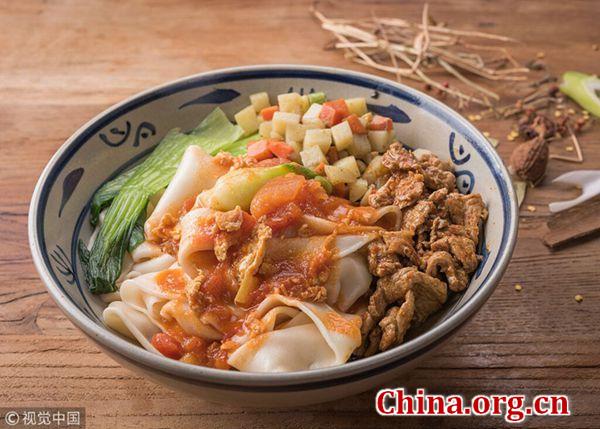One character to rule them all
- By Degen Hill
 0 Comment(s)
0 Comment(s) Print
Print E-mail China.org.cn, May 22, 2018
E-mail China.org.cn, May 22, 2018

Chinese characters, often regarded by foreigners as those unreadable squiggly lines, are used by millions of Chinese people every day. In fact, Chinese characters are the world's oldest continuously used system of writing. For the majority of characters, only a handful strokes are required, with more complicated ones requiring upwards of 10. However, there is a single character so complex and intricate, a total of 57 (or 58, depending on who you ask) strokes are used to write it.
You might be wondering what such a complicated character could represent. The aligning of two souls? A mighty warrior? The smell of the morning mist lingering on a flower? No. The most complex character in the Chinese language represents noodles—because of course it does.
The Origin
This character, in Pinyin (Chinese romanization) can be read as biángbiáng miàn, or biangbiang noodles, a dish of wide, flat noodles popular in the northwestern Chinese province of Shaanxi. Because it can't be found in dictionaries, the character's actual origins are a mystery. Some argue that it is a physical representation of the sound made when the chef slams the noodles against the table while making them. Others believe, and this is the most plausible, that the owner of a bygone noodle shop simply made it up. Maybe he was ahead of his time as a linguist, or maybe he just combined a bunch of different characters and claimed it as his own.
Despite having no definitive origin, this character is still widely used throughout China on restaurant signs, menus, and as a game to challenge Chinese people's writing ability. The closest thing to compare it to might be the made-up supercalifragilisticexpialidocious in the movie "Mary Poppins." Both have an unknown origin, their own Wikipedia page, and follow the rules of their respective languages; and although both have a distinct definition, are often used in a joking way.

The Character
So, does the character have any meaning among the 57 strokes? Biáng is actually just a combination of several other Chinese characters. These include 言 (speak; 7 strokes), 幺 (tiny; 2x3 strokes), 馬(horse; 10 strokes), 長 (grow; 2x8 strokes), 月 (moon; 4 strokes), 心 (heart; 4 strokes),刂 (knife; 2 strokes), 穴 (cave; 5 strokes) and 辶 (walk; 4 strokes). For most people, despite attempting to find logic in the character, biáng doesn't represent or mean anything other than delicious noodles. The reason this character is so challenging to write is that Chinese characters have something called a stroke order, requiring each character's strokes (the horizontal, vertical, and diagonal lines) to be written in a specific order. So just copying a character, despite it looking the same, would be labeled "incorrect" if the stroke order was wrong. As such, following the correct stroke order for the 57 strokes in biáng is no easy feat.
The Noodles
Learning how to write the most complicated Chinese character can be fun, but the question many people are interested in is: how are the noodles? In the province from whence they hail, they are known as one of the "eight strange wonders of Shaanxi." The noodles themselves are thick and wide, typically served in a broth accompanied by carrots, garlic, tofu, onion, ginger and seasoned with salt, allspice, chili powder, soy sauce, and vinegar. The noodles can be served with or without meat, made spicy with an oil-based sauce of finely chopped chili peppers, and are usually garnished with a sprig of cilantro.
A long time ago, biángbiáng noodles were thought to be eaten only by poor people in the countryside, but nowadays, they have gone mainstream due to the complex and unique character that has somehow come to represent them. The recipe may not have changed, but the mysterious and complex character has elevated these noodles to new heights.
Whether or not you are able to write the character, which even for many Chinese people remains a challenge, the noodles themselves are worth trying. The unique flavors that swirl around the thick, hearty noodles are reason enough, but it's also worth seeing a Chinese waitress smile as she sees a foreigner look up at her and say, "One order of biángbiáng miàn please."






Go to Forum >>0 Comment(s)